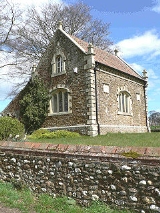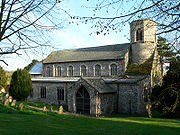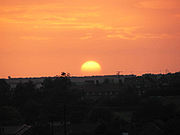
Sedgeford
Encyclopedia
Sedgeford is a civil parish
in the English county of Norfolk
, about 6 km south of the North Sea and 5 km (3.1 mi) east of the Wash
. It is approximately 90 km (55.9 mi) north east of Cambridge
.
It covers an area of 17.06 km² (6.6 sq mi) and had a population of 540 in 224 households as of the 2001 census
.
For the purposes of local government, it falls within the district
of King's Lynn and West Norfolk
.
 The parish church, Sedgeford St. Mary, is one of 124 round-tower church
The parish church, Sedgeford St. Mary, is one of 124 round-tower church
es in Norfolk.
The village lies in a fertile valley in the belt of chalk covering this area, with the small Docking river running through it. This river and the many springs feeding it have always ensured a good water supply for successive groups of people who have settled near it in the past.
The village is recorded in the Domesday Book
in 1086. Part of the church, built of flint and stone, is Anglo-Saxon in origin, and it is known from archæological evidence that people have lived here from much earlier times. There are remains of Roman villas, pottery and a gold torc
from the Iron Age
and many earlier artefacts, like the Neolithic
flint tools which are found in fields and gardens. Also it is crossed by two ancient roads - the prehistoric Icknield Way
and the Roman-period the Peddars Way
.
This is a predominantly agricultural area, with barley, wheat and sugar beet as the main crops, although tourism has become increasingly important in recent years.
Sedgeford has a village football team, Sedgeford FC. Sedgeford Fc play at the village playing field.
In 2010 they won NWNL Div 4 & NWNL Div 4 cup.
In 2011 they won Div 3 league and cup double, despite star player Chris May not turning up and having Paul Lough in the side.
2011/2012 season goalkeeper Will May was judged to be the longest in the shower.
. Legend has it that a secret tunnel ran from the old armoury to the church in the heart of the village. Today this small part of Peddars Way has derived its name from this historical building with Magazine Wood and Magazine Farm just a few steps away. All these properties were formerly owned by William Newcombe-Baker, a local land owner whose estate formed much of the land surrounding the village. He was also a founder member of NORMAC, the Norfolk machinery body that did much in the 20th century to bring modern mechanisation to arable farming in East Anglia. Magazine Wood was rebuilt in 2000 and from this high vantage point on Peddars Way you can witness the sun setting over the sea - one of the very few places this is possible on the east coast of Britain.
 Peddars Way passes Magazine Farm and then crosses the old railway-line. Sedgeford formerly had its own Sedgeford railway station
Peddars Way passes Magazine Farm and then crosses the old railway-line. Sedgeford formerly had its own Sedgeford railway station
on the line between Wells and King's Bling, but this was finally closed in 1963.
(SHARP) was established in 1996 to reconstruct the story of human settlement in the parish. This is an ongoing project; further details can be found on www.sharp.org.uk.
Civil parish
In England, a civil parish is a territorial designation and, where they are found, the lowest tier of local government below districts and counties...
in the English county of Norfolk
Norfolk
Norfolk is a low-lying county in the East of England. It has borders with Lincolnshire to the west, Cambridgeshire to the west and southwest and Suffolk to the south. Its northern and eastern boundaries are the North Sea coast and to the north-west the county is bordered by The Wash. The county...
, about 6 km south of the North Sea and 5 km (3.1 mi) east of the Wash
Wash
Wash may refer to:* Arroyo , also called a wash, a dry creek bed or gulch that temporarily fills with water after a heavy rain* WASH, a water, sanitation and hygiene advocacy campaign initiated by the Water Supply and Sanitation Collaborative Council...
. It is approximately 90 km (55.9 mi) north east of Cambridge
Cambridge
The city of Cambridge is a university town and the administrative centre of the county of Cambridgeshire, England. It lies in East Anglia about north of London. Cambridge is at the heart of the high-technology centre known as Silicon Fen – a play on Silicon Valley and the fens surrounding the...
.
It covers an area of 17.06 km² (6.6 sq mi) and had a population of 540 in 224 households as of the 2001 census
United Kingdom Census 2001
A nationwide census, known as Census 2001, was conducted in the United Kingdom on Sunday, 29 April 2001. This was the 20th UK Census and recorded a resident population of 58,789,194....
.
For the purposes of local government, it falls within the district
Non-metropolitan district
Non-metropolitan districts, or colloquially shire districts, are a type of local government district in England. As created, they are sub-divisions of non-metropolitan counties in a so-called "two-tier" arrangement...
of King's Lynn and West Norfolk
King's Lynn and West Norfolk
King's Lynn and West Norfolk is a local government district and borough in Norfolk, England. Its council is based in the town of King's Lynn.-History:...
.

Round-tower church
Round-tower churches are a type of church found mainly in England, almost solely in East Anglia; of about 185 surviving examples in the country, 124 are in Norfolk, 38 in Suffolk, 6 in Essex, 3 in Sussex and 2 each in Cambridgeshire and Berkshire. There is evidence of about twenty round-tower...
es in Norfolk.
The village lies in a fertile valley in the belt of chalk covering this area, with the small Docking river running through it. This river and the many springs feeding it have always ensured a good water supply for successive groups of people who have settled near it in the past.
The village is recorded in the Domesday Book
Domesday Book
Domesday Book , now held at The National Archives, Kew, Richmond upon Thames in South West London, is the record of the great survey of much of England and parts of Wales completed in 1086...
in 1086. Part of the church, built of flint and stone, is Anglo-Saxon in origin, and it is known from archæological evidence that people have lived here from much earlier times. There are remains of Roman villas, pottery and a gold torc
Torc
A torc, also spelled torq or torque, is a large, usually rigid, neck ring typically made from strands of metal twisted together. The great majority are open-ended at the front, although many seem designed for near-permanent wear and would have been difficult to remove. Smaller torcs worn around...
from the Iron Age
Iron Age
The Iron Age is the archaeological period generally occurring after the Bronze Age, marked by the prevalent use of iron. The early period of the age is characterized by the widespread use of iron or steel. The adoption of such material coincided with other changes in society, including differing...
and many earlier artefacts, like the Neolithic
Neolithic
The Neolithic Age, Era, or Period, or New Stone Age, was a period in the development of human technology, beginning about 9500 BC in some parts of the Middle East, and later in other parts of the world. It is traditionally considered as the last part of the Stone Age...
flint tools which are found in fields and gardens. Also it is crossed by two ancient roads - the prehistoric Icknield Way
Icknield Way
The Icknield Way is an ancient trackway in southern England. It follows the chalk escarpment that includes the Berkshire Downs and Chiltern Hills.-Background:...
and the Roman-period the Peddars Way
Peddars Way
The Peddars Way is a long distance footpath in Norfolk, England. It is 46 miles long and follows the route of a Roman road. It has been suggested by more than one writer that it was not created by the Romans but was an ancient trackway, a branch or extension of the Icknield Way, used and...
.
This is a predominantly agricultural area, with barley, wheat and sugar beet as the main crops, although tourism has become increasingly important in recent years.
Sedgeford has a village football team, Sedgeford FC. Sedgeford Fc play at the village playing field.
In 2010 they won NWNL Div 4 & NWNL Div 4 cup.
In 2011 they won Div 3 league and cup double, despite star player Chris May not turning up and having Paul Lough in the side.
2011/2012 season goalkeeper Will May was judged to be the longest in the shower.
Peddars Way
Peddars Way, the ancient Roman road, runs through the top end of the village and leads directly onto the Norfolk Coastal path. After Fring, the national trail passes through the hamlet of Littleport, a small row of higgledy-piggledy cottages which now form part of the main village. The route takes walkers past a local landmark Magazine Cottage, built in the 17th century by the Le Strange family during the civil war as a gunpowder magazineGunpowder magazine
A gunpowder magazine is a magazine designed to store the explosive gunpowder in wooden barrels for safety. Gunpowder, until superseded, was a universal explosive used in the military and for civil engineering: both applications required storage magazines...
. Legend has it that a secret tunnel ran from the old armoury to the church in the heart of the village. Today this small part of Peddars Way has derived its name from this historical building with Magazine Wood and Magazine Farm just a few steps away. All these properties were formerly owned by William Newcombe-Baker, a local land owner whose estate formed much of the land surrounding the village. He was also a founder member of NORMAC, the Norfolk machinery body that did much in the 20th century to bring modern mechanisation to arable farming in East Anglia. Magazine Wood was rebuilt in 2000 and from this high vantage point on Peddars Way you can witness the sun setting over the sea - one of the very few places this is possible on the east coast of Britain.

Sedgeford railway station
Sedgeford was a railway station which served the settlement of Sedgeford in Norfolk, England. Opened by the West Norfolk Junction railway in 1866, it closed with the line in 1952.- History :...
on the line between Wells and King's Bling, but this was finally closed in 1963.
Archaeological project
The Sedgeford Historical and Archaeological Research ProjectSedgeford Historical and Archaeological Research Project
The Sedgeford Historical and Archaeological Research Project is a long-term, multidisciplinary research project based in north-west Norfolk, UK. It is involved in the investigation of the local history and archaeology, with a strong emphasis on community involvement, practical training and education...
(SHARP) was established in 1996 to reconstruct the story of human settlement in the parish. This is an ongoing project; further details can be found on www.sharp.org.uk.
External links
- Website with photos of Sedgeford St. Mary, a Round-tower churchRound-tower churchRound-tower churches are a type of church found mainly in England, almost solely in East Anglia; of about 185 surviving examples in the country, 124 are in Norfolk, 38 in Suffolk, 6 in Essex, 3 in Sussex and 2 each in Cambridgeshire and Berkshire. There is evidence of about twenty round-tower...
- Sedgeford Village Online website
- Magazine Wood Website - Local information on things to do, places to visit, what's on and more
- Website with details of The King William Country Inn & Restaurant Sedgeford

